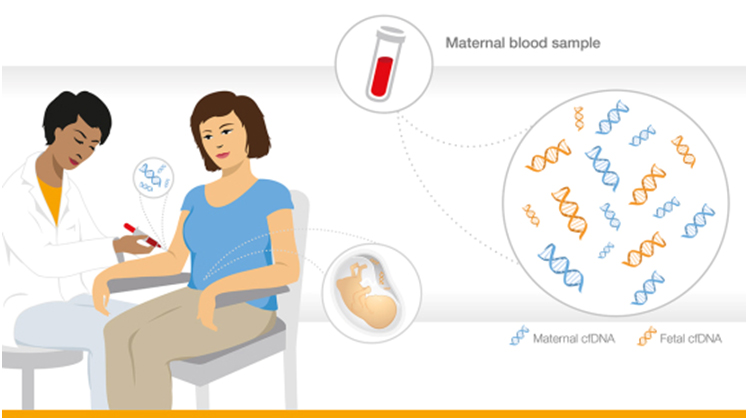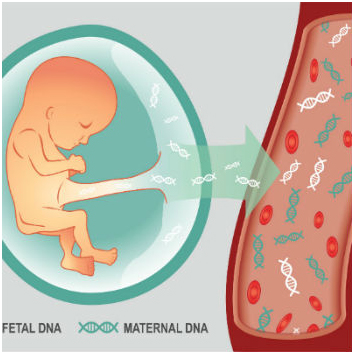NIPT
- Nipt
- The Non-invasive Prenatal test is used to detect chromosomal abnormalities such as Down syndrome in fetuses.
- Since the blood is only drawn from the mothers arm, it is non-invasive. Hence it eliminates the risk of miscarriage.
- It does not give a Yes/No answer but only gives a probability of the baby having a disorder but it is highly accurate.
- It can be done any time after 10 weeks of pregnancy.
- Sometimes there are chances of a false-positive or a false-negative or an indeterminate result.
What is NIPT for Down syndrome?
Non-invasive Prenatal Testing (NIPT) is a prenatal screening, which looks at DNA from the baby's placenta in a sample of the mother’s blood to identify whether the mother is at increased risk of giving birth to a child with a chromosomal disorder. A screening like NIPT cannot, however, determine for sure whether the baby actually has a chromosomal disorder, only the likelihood of having that condition. But even though it can’t tell for sure whether the baby has a genetic abnormality, it is highly accurate — 97 to 99 percent accuracy for three of the most common conditions. – Down syndrome, Edward’s syndrome, Patau syndrome.
The results of an NIPT screening can help determine whether to have a diagnostic test like Chorionic Villus Sampling (CVS) or amniocentesis . CVS and amniocentesis analyse a baby's own genetic material, collected from the placenta or amniotic fluid respectively, to tell with 100 percent certainty whether a baby has a chromosome abnormality. However they are invasive, which means they slightly increase the chance of miscarriage.
When is the test done?
NIPT can be performed any time after 9 weeks into the pregnancy — earlier than any other prenatal screening or diagnostic test. In comparison, nuchal translucency screening is done between weeks 11 and 13; CVS is done at 11to 13 weeks; the quad screen is completed between weeks 15and 21; and amniocentesis is usually performed between weeks 16 and 20.
What will NIPT reveal?
The results of an NIPT will indicate the likelihood – or risk factor – that the baby has one of the abnormalities tested for and does not provide a “Yes/No” answer If the baby has a high likelihood of having an abnormality, the obstetrician may suggest a diagnostic test, such as CVS or amniocentesis.
NIPTs only test for certain chromosomal abnormalities. They can't detect major malformations such as spina bifida (defect in the baby’s spine), so the mother should still have an ultrasound at around 12 weeks to see how the baby is developing.
The mother can choose to have an NIPT instead of a first trimester combined screening test, which combines an ultrasound and a blood test. A combined screening test is not as accurate as an NIPT, which is claimed to have an accuracy rate higher than 99 per cent.
Some patients choose to have an NIPT after another first trimester screening test returns a high-risk result.
How do NIPTs work?
NIPT works by analysing fragments of DNA from the baby, which are naturally present in the mother's blood stream. These fragments are called cell-free DNA (cfDNA).
Digital analysis of this cfDNA can identify babies with the following chromosomal abnormalities:
- Trisomy 13 – Patau syndrome.
- Trisomy 18 – Edward’s syndrome.
- Trisomy 21 – Down syndrome.
- Sex chromosome abnormalities involving X and Y chromosomes.
The results are reported as a probability. A low-risk test result would be less than 1 in 1,000 likelihood (or a 0.01 per cent chance that the baby has the abnormality), while a very high-risk result would be 1 in 2 likelihood (or a 50 per cent chance the baby has the abnormality).
As it is only a screening test, if the result shows a high likelihood of a chromosomal abnormality, it's still necessary to carry out a diagnostic test, such as CVS or amniocentesis, to determine whether the baby actually has the abnormality.
NIPT results are usually returned within 15 days if the samples are sent overseas for analysis.
How is NIPT done?
Because an NIPT involves only a quick blood draw from the mother’s arm with a needle and syringe, it's safe for the mother and the baby. The sample is then sent to a lab, where the baby’s DNA fragments in the blood is analysed for signs of abnormalities.

Are there any risks with having an NIPT?
An NIPT is done via a blood sample from the pregnant woman, so the risk of any complications is very low, and it doesn't have the same risk of miscarriage as a invasive test.
Sometimes the test can fail because the amount of cfDNA in the blood sample may be too low to be analysed. Levels of cfDNA gradually increase with gestation so trying again is an option.
What results can we get from NIPT for Down syndrome?
There are three possible results from NIPT for Down syndrome:
- Positive: Predicted to be affected by Down syndrome. An invasive test should be offered to confirm the result.
- Negative: Highly unlikely to be affected by Down syndrome.
- Inconclusive: Inconclusive results. This is usually because the proportion of fetal DNA present in the sample is not high enough to give an accurate result. NIPT may be repeated with the hope that the cffDNA levels will have increased due to the increased gestation.
Accuracy and reliability of NIPT
The NIPT is still a highly accurate screening test that gives a risk factor, not a diagnosis.
NIPT can be used as screening tests for low-risk and high-risk women. As the chance of genetic disorders increases with age it's expected that older women would benefit most from testing and may be able to avoid invasive tests.
There are a number of reasons why false positive results happen; for example, if the test is done early in the pregnancy, it may detect DNA left over from a vanishing twin that has been absorbed by the mother or by the surviving twin. In rare cases, maternal cell-free DNA may be mistaken for the baby’s, and the mother’s genetic problems may be attributed to the baby.
If the mother is overweight or obese, there may be too little baby DNA in her blood, which may cause a false negative test result or an indeterminate result.
There is another possible reason for inaccurate NIPT results: cell-free fetal DNA comes from the placenta, and there are sometimes “cell lines” that grow in the placenta but not in the baby. This may cause a false negative test result if an abnormal cell line is present in the baby but not present in the placenta, or a false positive if present only in the placenta, not in the baby.

How does NIPT detect Down syndrome?
People normally have 23 pairs of chromosomes in each cell (see the karyotype below left). Each chromosome is made of a coil of DNA which contains genes. These give instructions to the body to tell it how to work. Down syndrome occurs when a person has an extra copy of chromosome 21 (see the karyotype, below right). Having this extra genetic information is what causes the malformed physical and mental characteristics of people who have Down syndrome.
NIPT also checks for,

- Trisomy 18 – Edward’s syndrome - a condition that causes severe physical and mental abnormalities; it is the result of an extra chromosome, known as trisomy-18
- Trisomy 13 - Patau syndrome - a rare but serious condition where babies rarely survive for more than a few days; it is the result of an extra chromosome, known as trisomy-13.
Each chromosome has sequences of DNA that are specific to that particular chromosome. Therefore, by analysing and counting all the DNA sequences that link or map to each individual chromosome, the total amount of chromosome 21 in the mother’s blood can be compared with the amount of the other chromosomes. If the baby has Down syndrome, there will be slightly more sequences that map to chromosome 21 than expected, indicating that there is more chromosome 21 present than normal. This allows very accurate prediction of pregnancies where the fetus is likely to have Down syndrome.
Cell-free fetal DNA (cffDNA) comes from the placenta. It is first detectable from about 4-5 weeks’ gestation and reaches the required level needed to test for Down syndrome by 10 weeks’ gestation in most pregnancies.
How is NIPT different from the combined/quadruple test?
Although both tests involve a sample of maternal blood, NIPT analyses the cell-free DNA in the mother’s blood, whereas the combined and quadruple test analyses the mother’s hormone levels. With more than 98% accuracy, NIPT is more accurate than the first trimester combined test or second trimester quadruple test for estimating the chance or the risk that the baby has Down syndrome
